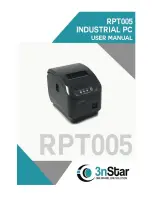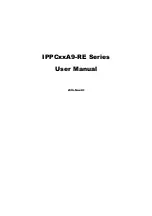
13
3 Protection setting description
PXR tRiP units foR PoweR Defense molDeD case ciRcuit bReakeRs
MN012007EN June 2018 www.eaton.com
•
For locally actuating the maintenance mode function, use the slide switch on the front of
the trip unit. When in the “ON” position, maintenance mode is enabled locally and cannot
be turned-off remotely or by communications. This method does not require auxiliary
power to the trip unit, and the blue LED on the face of trip unit will light when the trip unit
is self-powered.
•
Maintenance mode can be remotely actuated by an external contact wired to the breaker
when the local switch is in the “OFF/Remote” position. See Section 5.1: Wiring table for
details regarding the contact and wiring length. Auxiliary power (24 V DC) is required for
this functionality.
•
A third method to actuate maintenance mode is via communications. This can be done
through a modbus register, a communications adapter module (CAM) or by the configura-
tion software using the USB port. When maintenance mode is enabled by communica-
tions, it must also be disabled via communications. Moving the local switch from “OFF/
Remote” to “ON” and back to “OFF/Remote” will not disable maintenance mode.
Auxiliary power (24 V DC) is required for communications functionality, including mainte-
nance mode remote activation.
Use one of the general-purpose, configurable, relay contacts to remotely indicate when
maintenance mode is active. Auxiliary power (24 V DC) is required for the remote indication
via a relay contact.
3.7 Override
The PXR trip unit provides an override trip function that will trip the circuit breaker at the
withstand rating of the circuit breaker frame. This function is factory set and reacts to the
peak current level. It is always active regardless of the user’s instantaneous adjustment
selection. The instantaneous (“INST”) indicator shows this cause-of-trip.
3.8 Zone selective interlocking (ZSI)
The zone selective interlocking (ZSI) function is an option when ordering the circuit breaker.
ZSI functions in conjunction with the short delay and ground fault protection functions. ZSI
provides the fastest possible tripping for faults within the zone of protection of the circuit
breaker and also provides positive coordination among all circuit breakers in the system
(mains, ties, feeders, and downstream circuit breakers). Application note (AP02602002E) is
available and has additional detail.
When ZSI is enabled, a fault within the zone of protection will immediately trip the breaker
and send a signal to upstream trip units to restrain them from tripping immediately. The
restraining signal causes the upstream circuit breakers to follow their set coordination time
delays so that the service is interrupted to the isolated fault area only while the fault is
cleared in the shortest time possible.
The ZSI is wired using a set of three wires labeled zone in (Zin), zone out (Zout), and zone
common (Zcom). These signals are compatible will all Eaton circuit breakers which have
the ZSI function. The zone out signal is sent whenever a ground fault pickup or short delay
pickup is exceeded. This provides maximum selectivity for coordination with larger upstream
circuit breakers.
ZSI in the PXR trip unit is fully compatible with ZSI in the Digitrip for Magnum, Digitrip for
NRX, OPTIM and 310+ Series C and Series G trip units. If a PXR trip unit has the ZSI option
but it is not needed in an application, it may be disabled using the Power Xpert Protection
Manager software or the menus on the UI, or the Zout and Zin may be connected to “self-
interlock” the unit.
PXR trip units with a display have a visual indication of the ZSI system being active and
connected to the other breakers in the ZSI system. A small check-mark will appear next to
the ZSI when the trip unit receives a ZSI-IN signal. The general-purpose, configurable, relay
contacts may also be programmed to indicate ZSI signals and status.
















































